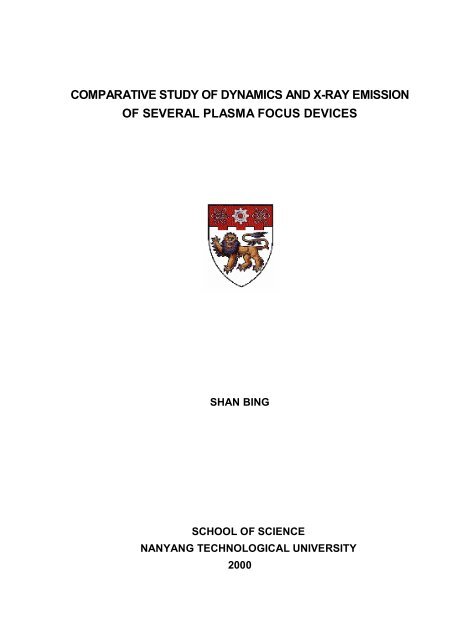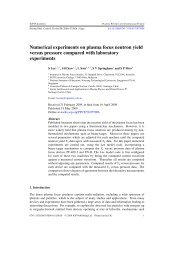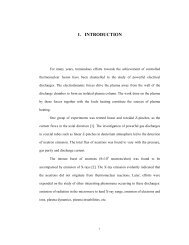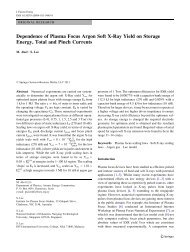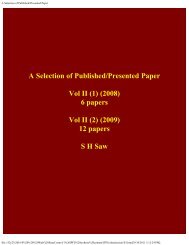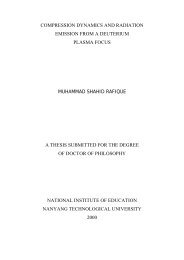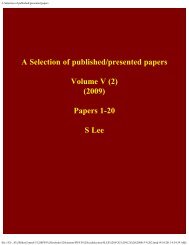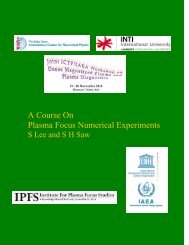comparative study of dynamics and x-ray emission of several ...
comparative study of dynamics and x-ray emission of several ...
comparative study of dynamics and x-ray emission of several ...
Create successful ePaper yourself
Turn your PDF publications into a flip-book with our unique Google optimized e-Paper software.
COMPARATIVE STUDY OF DYNAMICS AND X-RAY EMISSION<br />
OF SEVERAL PLASMA FOCUS DEVICES<br />
SHAN BING<br />
SCHOOL OF SCIENCE<br />
NANYANG TECHNOLOGICAL UNIVERSITY<br />
2000
COMPARATIVE STUDY OF DYNAMICS AND X-RAY EMISSION<br />
OF SEVERAL PLASMA FOCUS DEVICES<br />
SHAN BING<br />
SUPERVISED<br />
BY<br />
PROFESSOR LEE SING<br />
A THESIS SUBMITTED<br />
FOR THE DEGREE OF DOCTOR OF PHILOSOPHY<br />
PHYSICS DIVISION, SCHOOL OF SCIENCE<br />
NANYANG TECHNOLOGICAL UNIVERSITY<br />
2000
Acknowledgments<br />
I wish to express my deepest gratitude <strong>and</strong> thanks to my supervisor<br />
Pr<strong>of</strong>essor Lee Sing (School <strong>of</strong> Science, National Institute <strong>of</strong> Education, Nanyang<br />
Technological University, Head <strong>of</strong> Physics Division) for his kind directions,<br />
inspiring guidance, <strong>and</strong> invaluable discussions throughout the course. Without<br />
his patience <strong>and</strong> encouragement, this work would never be fulfilled. I am very<br />
grateful to have such a fulfilling <strong>and</strong> enriching experience <strong>of</strong> working under<br />
him.<br />
I am also very grateful to Dr. Liu Mahe, Dr. Paul Lee Choon Keat <strong>and</strong> Dr.<br />
Rajdeep Singh Rawat, for their invaluable suggestions <strong>and</strong> discussions ranging<br />
from basic concepts to complicated PF modeling. They also joined some<br />
experiments with NX2 <strong>and</strong> always give me generous help when I have<br />
difficulties.<br />
I would also wish to express thanks <strong>and</strong> appreciation to Dr. Takeshi<br />
Yanagidaira <strong>of</strong> Gunma University. He provided me with the parameters <strong>and</strong> the<br />
newest results <strong>of</strong> the gas-puffed Gunma plasma focus. The discussions over<br />
internet with him did me a great help in modeling the Gunma machine.<br />
I would also like to express thanks to Mr. Alin-Constantin Patran for<br />
providing <strong>and</strong> operating UNU/ICTP PFF with me. I am very impressed by his<br />
zealous attitude <strong>and</strong> skilled working ability.<br />
Thanks are also due to Mr. Ashutosh Srivastava, who collaborated with<br />
me going through with all the experiments with NX2.<br />
I am also very thankful to all the various people <strong>of</strong> the plasma research<br />
group for their help <strong>and</strong> friendship, in particular: Pr<strong>of</strong>. Vladimir A Gribkov, Dr.<br />
Muhammed Shahid Rafique, Miss Cecelia M.N. Selvam, Dr. Adrain Serban, Dr.<br />
i
S. V. Springham <strong>and</strong> Dr. Vladmir Kudryashov. It has been a pleasant<br />
experience to work with them.<br />
Special thanks are given to Pr<strong>of</strong>. Hou Xun (Member <strong>of</strong> the Chinese<br />
Academy <strong>of</strong> Sciences, Chairman <strong>of</strong> the Academic Council <strong>of</strong> Xi'an Institute <strong>of</strong><br />
Optics <strong>and</strong> Precision Mechanics, Chinese Academy <strong>of</strong> Sciences) <strong>and</strong> my father,<br />
Pr<strong>of</strong>. Shan Lun (Academician <strong>of</strong> the Chinese Academy <strong>of</strong> Engineering, Delegate<br />
<strong>of</strong> the National People's Congress, Chairman <strong>of</strong> the Academic Council <strong>of</strong><br />
Northwest Institute <strong>of</strong> Soil <strong>and</strong> Water Conservation, Chinese Academy <strong>of</strong><br />
Science) for their constant confidence on me that encourage <strong>and</strong> inspire me to<br />
work hard in the scientific research.<br />
In addition, many other people in NIE have given me h<strong>and</strong>s in a variety<br />
<strong>of</strong> aspects ranging from daily life to sophisticated research. Their names,<br />
though not mentioned herewith, are remembered in the innermost recesses <strong>of</strong><br />
my heart.<br />
Finally, I am deeply indebted to my wife Yang Hongsa <strong>and</strong> my lovely<br />
daughter Shan Shan for all their support <strong>and</strong> underst<strong>and</strong>ing. In the whole<br />
course, they give me a sweet home which I cannot find words to express my<br />
appreciation.<br />
ii
Abstract<br />
This thesis describes the theoretical <strong>and</strong> experimental investigations <strong>of</strong> the<br />
x-<strong>ray</strong> radiation properties <strong>and</strong> the plasma <strong>dynamics</strong> in <strong>several</strong> plasma focus<br />
devices. The purpose <strong>of</strong> the research is to optimize the x-<strong>ray</strong> radiation behavior<br />
<strong>of</strong> the plasma focus <strong>and</strong> to seek the conditions for generating shorter<br />
wavelength x-<strong>ray</strong>s with argon gas.<br />
The characteristics <strong>of</strong> neon <strong>and</strong> argon plasmas are investigated in detail<br />
based on the corona model. The results show that much higher temperature<br />
<strong>and</strong> energy are required to generate x-<strong>ray</strong> radiative argon plasma. This explains<br />
why it is much easier to obtain s<strong>of</strong>t x-<strong>ray</strong>s from the neon plasma focus.<br />
An improved plasma focus model is proposed with emphasis on detailed<br />
analysis <strong>of</strong> energy transfer processes <strong>and</strong> thermodynamic processes. Agreement<br />
between the experiment results <strong>and</strong> the computations for neon <strong>and</strong> argon is<br />
noted.<br />
The model is extended to describe, for comparison purpose, the gas-puff<br />
plasma focus. Modifications are made based on the measured gas pressure<br />
pr<strong>of</strong>ile <strong>and</strong> assumed gas composition. Applying the modified model to the gas-<br />
puff focus <strong>of</strong> Gunma University reveals that the gas-puff scheme is more<br />
efficient to heat the plasma <strong>and</strong> to generate x-<strong>ray</strong>s. And it also results in a more<br />
stable plasma column. By comparing with published results, agreement is<br />
obtained in the major points regarding plasma <strong>dynamics</strong>, plasma column<br />
stability <strong>and</strong> appearance, plasma temperature, <strong>and</strong> x-<strong>ray</strong> radiation properties.<br />
Experiments are mainly carried out with the repetitive NX2 plasma focus,<br />
under various charging voltage <strong>and</strong> gas pressure with a series <strong>of</strong> anode lengths.<br />
iii
A Rogowski current derivative coil, a resistive voltage divider, <strong>and</strong> a PCD x-<strong>ray</strong><br />
detector are installed to measure the current derivative, tube voltage <strong>and</strong> x-<strong>ray</strong><br />
signal. All these detectors have been carefully calibrated to give quantitative<br />
information. A fast four-channel data acquisition system has been set up to<br />
record the fast data flow from the high-repetitive rate machine.<br />
X-<strong>ray</strong> radiation properties from the plasma focus with neon have been<br />
investigated in detail. The optimized working region is located by scanning the<br />
working conditions. The x-<strong>ray</strong> yield in this region is ~ 12 Joule/shot with the<br />
peak power in the GW order. The correlation between x-<strong>ray</strong> yield with various<br />
operating parameters such as repetition rate <strong>and</strong> reproducibility is studied.<br />
The <strong>dynamics</strong> <strong>of</strong> the plasma focus is studied with the recorded current<br />
<strong>and</strong> voltage signal. The correlations <strong>of</strong> discharge current, focusing time, tube<br />
inductance, axial speed <strong>and</strong> detail features <strong>of</strong> x-<strong>ray</strong> radiation are investigated.<br />
Efforts <strong>of</strong> generating argon x-<strong>ray</strong>s in NX2 are made under various<br />
experimental conditions. However, in argon the NX2 device does not focus in<br />
the expected high voltage, low pressure working region. The experiments are<br />
then carried out in the UNU/ICTP PFF (United Nations University/International<br />
Center for Theoretical Physics Plasma Focus Facility) to <strong>study</strong> the mechanism<br />
for argon x-<strong>ray</strong>s. The characteristic Ar lines are recognized from the measured<br />
signal. The neon experiments are also carried out with this machine for<br />
comparison. The results show the optimized working pressure for neon x-<strong>ray</strong> is<br />
much higher than for argon. This confirms the theoretical conclusions that<br />
mush higher energy <strong>and</strong> temperature are required to generate x-<strong>ray</strong> from argon<br />
plasma.<br />
iv
Author’s Publications during 1999 – 2000 (Related to this thesis):<br />
[1] B. Shan, T. Yanagidaira, <strong>and</strong> K. Shimoda, “A gated, four-frame pinhole camera with<br />
quantitative image acqusition”, Jpn. J. Appl. Phys., 38(1999)1558-1563<br />
[2] B. Shan, T. Yanagidaira, K. Shimoda, <strong>and</strong> K. Hirano, “Quantitative measurement <strong>of</strong><br />
x-<strong>ray</strong> images with a gated microchannel plate system in a z-pinch plasma<br />
experiment”, Rev. Sci. Instrum., 70(1999)1688-1693<br />
[3] T. Yanagidaira, T. Yamamoto, B. Shan, <strong>and</strong> K. Hirano, “Spectroscopic investigation<br />
<strong>of</strong> z-pinch with a spatial <strong>and</strong> temporal resolution”, Jpn. J. Phys. Soc., 68(1999)852-<br />
856<br />
[4] R.S. Rawat, W.M. Chew, P. Lee, T. White, B. Shan, S.P. Moo <strong>and</strong> S. Lee, “Roomtemperature<br />
growth <strong>of</strong> titanium nitride thin films on 304-stainless steel substrates<br />
using plasma focus device”, Regional Meeting on Plasma Research in 21 st Century,<br />
Bangkok, Thail<strong>and</strong>, 7-12 May 2000, to be published<br />
[5] B. Shan, M.H. Liu, R. S. Rawat, <strong>and</strong> S. Lee, “X-<strong>ray</strong> Emission Properties <strong>of</strong> Neon <strong>and</strong><br />
Argon Plasmas in Conventional <strong>and</strong> Gas-puff Plasma Focus Devices”, Regional<br />
Meeting on Plasma Research in 21 st Century, Bangkok, Thail<strong>and</strong>, 7-12 May 2000, to<br />
be published<br />
[6] M.H. Liu, B. Shan <strong>and</strong> S. Lee, “Optimum plasma temperatures for neon <strong>and</strong> argon<br />
SXR output in plasma focus”, submitted<br />
[7] B. Shan, P. Lee, M.H. Liu, <strong>and</strong> S. Lee, “Improving the Energy Efficiency <strong>of</strong> Plasma<br />
Focus Devices”, submitted<br />
[8] B. Shan, M.H. Liu, P. Lee, <strong>and</strong> S. Lee, “Simulations With Conventional <strong>and</strong> Gas-puff<br />
Plasma Focus Devices”, submitted<br />
v
CHAPTER 1<br />
Introduction<br />
Table <strong>of</strong> Contents<br />
1.1. Research Background 1<br />
1.1.1. X-<strong>ray</strong>s <strong>and</strong> plasma x-<strong>ray</strong>s 1<br />
1.1.2. X-<strong>ray</strong>s from plasma focus 2<br />
1.1.3. Plasma focus x-<strong>ray</strong>s for lithography 3<br />
1.1.4. Scope <strong>of</strong> research 4<br />
1.2. Plasma Focus Device: Structure & Dynamics 7<br />
1.2.1. Structure <strong>and</strong> working principle 7<br />
1.2.2. Breakdown phase 10<br />
1.2.3. Axial rundown phase 11<br />
1.2.4. Radial phase 13<br />
1.3. X-<strong>ray</strong> Radiation from Plasma Focus 19<br />
1.3.1. Classification <strong>of</strong> x-<strong>ray</strong> sources 19<br />
1.3.2. Development <strong>of</strong> the plasma focus x-<strong>ray</strong> source 19<br />
1.3.3. Characteristics <strong>of</strong> plasma focus x-<strong>ray</strong> source 21<br />
CHAPTER 2<br />
CHARACTERISTICS OF NEON AND ARGON PLASMAS<br />
2.1. Simplified Plasma Equilibrium Model for Plasma Focus 26<br />
2.1.1. General consideration <strong>of</strong> plasma equilibrium model 26<br />
2.1.2. Corona model 28<br />
2.1.3. Calculate ionization states 29<br />
2.2. Calculations for Argon <strong>and</strong> Neon Plasmas Using Corona Model 31<br />
2.2.1. Equilibrium properties 31<br />
2.2.2. Estimate the working parameters <strong>of</strong> neon <strong>and</strong> argon plasmas in<br />
plasma focus 34<br />
2.3. X-<strong>ray</strong> Emission Properties <strong>of</strong> Argon <strong>and</strong> Neon Plasmas 37<br />
2.3.1. General x-<strong>ray</strong> <strong>emission</strong> processes from plasmas 37<br />
vi
2.3.2. X-<strong>ray</strong> power density from plasmas 40<br />
2.3.3. X-<strong>ray</strong> <strong>emission</strong> intensities from neon plasma 42<br />
2.3.4. X-<strong>ray</strong> <strong>emission</strong> intensities from argon plasma 46<br />
2.3.5. Optimized conditions for x-<strong>ray</strong> radiative neon <strong>and</strong> argon plasmas 47<br />
CHAPTER 3<br />
DYNAMIC PROCESSES AND MODEL OF PLASMA FOCUS<br />
3.1. Introduction 48<br />
3.1.1. Simplified evolution processes in plasma focus 48<br />
3.1.2. Symbols <strong>and</strong> notations used in the modeling 52<br />
3.2. Electrical Properties <strong>and</strong> Circuit Equations 54<br />
3.2.1. Equivalent circuit equations 54<br />
3.2.2. Axial phase 56<br />
3.2.3. Radial phase 57<br />
3.2.4. Plasma resistance 58<br />
3.3. Shock Wave <strong>and</strong> Shock Wave Equations 59<br />
3.3.1. Equations for 1D shock wave 59<br />
3.3.2. Parameters for 1D shock wave 61<br />
3.3.3. 1D shock waves with changing piston pressure or changing ambient<br />
gas pressure 62<br />
3.3.4. Shock wave for 2D cylindrical configuration 64<br />
3.4. Plasma as Thermodynamic Gases 67<br />
3.4.1. Thermodynamic properties <strong>of</strong> plasma gas 67<br />
3.4.2. Effective specific heat ratio <strong>of</strong> plasma gas 69<br />
3.4.3. Thermodynamic equation for plasmas 71<br />
3.5. Energies <strong>and</strong> Temperature <strong>of</strong> the Plasma in Plasma Focus 72<br />
3.5.1. Mechanisms <strong>of</strong> energy transfer into plasma <strong>and</strong> plasma tube 72<br />
3.5.2. Driving parameter S 74<br />
3.5.3. Energy transfer process 76<br />
3.6. Equations <strong>and</strong> Expressions <strong>of</strong> the Plasma <strong>and</strong> Plasma Focus 78<br />
3.6.1. Axial phase 78<br />
3.6.2. Radial inward shock phase 79<br />
3.6.3. Reflected shock equation 82<br />
vii
3.6.4. Slow compression equation 83<br />
3.6.5. Dependence <strong>of</strong> the plasma <strong>dynamics</strong> on gas properties 83<br />
3.7. Simulation With NX2 Plasma Focus Machine 85<br />
3.7.1. Numerical calculating method 85<br />
3.7.2. Results for NX2 plasma focus machine 86<br />
3.8. Modifications for Gas Puff Plasma Focus Machine 92<br />
3.8.1. Pressure distribution in gas puff plasma focus machine 92<br />
3.8.2. Modification <strong>of</strong> equations for gas puff plasma focus 95<br />
3.8.3. Simulation results for Gunma machine 96<br />
CHAPTER 4<br />
NX2 PLASMA FOCUS MACHINE AND DIAGNOSTIC TOOLS<br />
4.1. Technical Consideration in System Construction 100<br />
4.2. System Arrangement 104<br />
4.2.1. Layout 104<br />
4.2.2. Vacuum chamber <strong>and</strong> DPF head 105<br />
4.2.3. Electrodes <strong>and</strong> insulators 107<br />
4.2.4. Cooling system 108<br />
4.3. Electrical Structure 109<br />
4.3.1. Layout 109<br />
4.3.2. Energy bank <strong>and</strong> charger 111<br />
4.3.3. Switches 120<br />
4.4. Diagnostics <strong>of</strong> NX2 Machine 115<br />
4.4.1. Measurement <strong>of</strong> discharge current 115<br />
4.4.2. Measurement <strong>of</strong> tube voltage 116<br />
4.4.3. Measurement <strong>of</strong> x-<strong>ray</strong> signal from plasma 117<br />
4.4.4. Calibration <strong>of</strong> the x-<strong>ray</strong> detector system used in NX2 119<br />
4.4.5. Data acquisition system 123<br />
4.4.6. Data processing 127<br />
4.5. Measurement <strong>of</strong> Circuit Parameters by Short Circuit Test 129<br />
4.5.1. Principle 129<br />
4.5.2. Circuit parameters <strong>of</strong> NX2 machine 131<br />
viii
CHAPTER 5<br />
EXPERIMENTAL RESULTS AND DISCUSSION<br />
5.1. General 134<br />
5.2. Optimizing for X-<strong>ray</strong> Output with Neon Gas 136<br />
5.2.1. Optimizing X-<strong>ray</strong> output by changing anode length, working voltage,<br />
gas pressure <strong>and</strong> anode material 136<br />
5.2.2. Reproducibility <strong>of</strong> the X-<strong>ray</strong> Output 141<br />
5.2.3. Dependence on repetition rate 143<br />
5.3. Plasma Focus Dynamics <strong>and</strong> Parameter Correlation 145<br />
5.3.1. General characteristics <strong>of</strong> discharge current 145<br />
5.3.2. Focusing time 148<br />
5.3.3. Tube inductance <strong>and</strong> axial speed 152<br />
5.3.4. Energy & power into plasma focus tube 155<br />
5.3.5. Detailed features <strong>of</strong> the x-<strong>ray</strong> radiation pulse 156<br />
5.3.6. Plasma <strong>dynamics</strong> for different gases 160<br />
5.4. Argon x-<strong>ray</strong> from NX2 162<br />
5.5. Experiment with UNU/ICTP PFF 167<br />
5.5.1. System arrangement 167<br />
5.5.2. Results from argon 171<br />
5.5.3. Results from neon 176<br />
CHAPTER 6<br />
CONCLUSIONS AND SUGGESTED FUTURE WORKS<br />
6.1. Conclusions 179<br />
6.2. Suggested Future Works 184<br />
APPENDIX<br />
A. Parameters for related plasma focus machines 187<br />
B. Characteristic data for working gases 189<br />
C. Symbols <strong>and</strong> equations <strong>of</strong> plasma focus model 193<br />
REFERENCES 199<br />
ix
List <strong>of</strong> Figures<br />
1-1 A test lithography result by a plasma focus x-<strong>ray</strong> source 4<br />
1-2 Mather <strong>and</strong> Filippov-type Plasma Focus devices 7<br />
1-3 Gas puff plasma focus device (Gunma machine) 9<br />
1-4 Plasma compression process captured by a gated MCP camera 15<br />
2-1 Neon Ion fractions at different temperature 31<br />
2-2 Argon Ion fractions at different temperature 32<br />
2-3 Effective ionization number <strong>of</strong> argon, neon <strong>and</strong> hydrogen 33<br />
2-4 Thermal & ionization energies for generating plasmas 35<br />
2-5 Bound-bound, free-bound <strong>and</strong> free-free transitions 38<br />
2-6 Emission intensities <strong>of</strong> neon Lyα, Lyβ, Heα, <strong>and</strong> Heβ lines 44<br />
2-7 Continua <strong>emission</strong> intensities <strong>of</strong> Ne 10+ , Ne 9+ <strong>and</strong> Ne 8+ ions 45<br />
2-8 Emission intensities <strong>of</strong> argon Lyα <strong>and</strong> Heα lines 46<br />
2-9 X-<strong>ray</strong> (Lyα + Heα ) intensities <strong>of</strong> argon <strong>and</strong> neon plasmas 47<br />
3-1 Simplified processes in plasma focus 49<br />
3-2 Equivalent circuit structure <strong>of</strong> the plasma focus 54<br />
3-3 Typical discharge current traces in NX2 55<br />
3-4 Equivalent plasma configuration in axial phase 56<br />
3-5 Equivalent radial phase configuration 57<br />
3-6 Shock wave induced by a fast piston 60<br />
3-7 Relationship between shock speed <strong>and</strong> shock temperature 61<br />
3-8 Equivalent geometry for the cylindrical compression 64<br />
3-9 Calculated specific heat ratio <strong>of</strong> neon <strong>and</strong> argon gases 71<br />
3-10 Energy transfer process in plasma focus 77<br />
3-11 Simulation results <strong>of</strong> NX2 87<br />
3-12 Simulated evolution in radial inward shock phase <strong>of</strong> NX2 88<br />
3-13 Simulated plasma temperature vs. gas pressure for neon in NX2 90<br />
3-14 Simulated plasma temperature vs. gas pressure for argon in NX2 91<br />
3-15 Measured gas pressure pr<strong>of</strong>ile with the gas-puffed Gunma Machine 92<br />
3-16 Gas pressure pr<strong>of</strong>ile <strong>and</strong> constitution for simulation 94<br />
3-17 Simulation results <strong>of</strong> Gunma machine 98<br />
3-18 Evolution in radial inward shock phase <strong>of</strong> Gunma machine 99<br />
x
4-1 Block diagram <strong>of</strong> NX2 plasma focus 102<br />
4-2 Overall view <strong>of</strong> the NX2 plasma focus machine 104<br />
4-3 Front view <strong>of</strong> the main body <strong>of</strong> NX2 105<br />
4-4 Vacuum chamber <strong>and</strong> plasma focus head in NX2 106<br />
4-5 Electrical structure <strong>of</strong> NX2 Plasma Focus Machine 110<br />
4-6 Block diagram <strong>of</strong> HVPS 802 power supply 111<br />
4-7 Output power & current <strong>of</strong> the HVPS 802 power supply 112<br />
4-8 Structure <strong>of</strong> the rail gap switch 113<br />
4-9 Rogowski coil & its equivalent circuit 115<br />
4-10 Schematic <strong>of</strong> the resistive voltage probe 117<br />
4-11 Metal-insulator-metal PCD x-<strong>ray</strong> detector 118<br />
4-12 Spectrum weight for x-<strong>ray</strong> calibration 121<br />
4-13 Fast measurement system in NX2 124<br />
4-14 Typical results by the NX2 measurement system 125<br />
4-15 Processed results <strong>of</strong> the data in Fig. 4-14 128<br />
4-16 Get circuit parameters by short circuit test 132<br />
5-1 X-<strong>ray</strong> energy, peak power <strong>and</strong> focusing depth versus charging voltage <strong>and</strong><br />
gas pressure with 5.0 cm stainless steel anode 137<br />
5-2 X-<strong>ray</strong> energy, peak power <strong>and</strong> focusing depth versus charging voltage <strong>and</strong><br />
gas pressure with 5.0 cm copper anode 138<br />
5-3 X-<strong>ray</strong> energy, peak power <strong>and</strong> focusing depth versus charging voltage <strong>and</strong><br />
gas pressure with 4.3 cm copper anode 139<br />
5-4 Correlation between x-<strong>ray</strong> peak power <strong>and</strong> x-<strong>ray</strong> yield 140<br />
5-5 Histogram <strong>of</strong> X-<strong>ray</strong> intensity distribution 141<br />
5-6 X-<strong>ray</strong> reproducibility <strong>of</strong> 5.0cm stainless steel anode 142<br />
5-7 Working properties' dependence on repetition rate 143<br />
5-8 Discharge current at different charging voltage 146<br />
5-9 Current traces at different gas pressure 146<br />
5-10 Simulated current traces for NX2 plasma focus 147<br />
5-11 Focusing time <strong>of</strong> the 4.3 cm Cu anode with neon gas 150<br />
5-12 Correlation between x-<strong>ray</strong> yield <strong>and</strong> focusing time <strong>of</strong> 5.0 cm stainless steel<br />
anode 151<br />
5-13 Correlation between focusing time <strong>and</strong> x-<strong>ray</strong> Yield <strong>of</strong> 4.3 cm Cu anode 151<br />
5-14 Tube inductance <strong>and</strong> axial speed 153<br />
5-15 Details <strong>of</strong> the tube inductance <strong>and</strong> axial speed 154<br />
xi
5-16 Energy & power into PF tube 155<br />
5-17 Details feature <strong>of</strong> the X-<strong>ray</strong> radiation <strong>and</strong> dI/dt signal 157<br />
5-18 Detailed neon x-<strong>ray</strong> pulses from different working pressures 158<br />
5-19 dI/dt traces for neon <strong>and</strong> deuterium at same mass density 160<br />
5-20 Four channel signals from NX2 with argon gas 163<br />
5-21 Compare detailed features <strong>of</strong> argon <strong>and</strong> neon x-<strong>ray</strong> pulses 164<br />
5-22 Overall dI/dt traces <strong>of</strong> neon <strong>and</strong> argon with same mass density 165<br />
5-23 Simulated radial speed <strong>and</strong> dI/dt <strong>of</strong> neon <strong>and</strong> argon 166<br />
5-24 Technical parameters & x-<strong>ray</strong> Sensitivities <strong>of</strong> BPX65 diode 169<br />
5-25 Five-channel PIN x-<strong>ray</strong> detector 169<br />
5-26 Sensitivities <strong>of</strong> the five-channel pin-diode detectors 170<br />
5-27 Sensitivity ratio <strong>of</strong> channel 2 to channel 3 171<br />
5-28 Discharge current traces at different pressures <strong>of</strong> argon 172<br />
5-29 Argon x-<strong>ray</strong> signals from UNU/ICTP PFF 172<br />
5-30 X-<strong>ray</strong> signals from 0.75 mbar argon 173<br />
5-31 X-<strong>ray</strong> signals from 0.25 mbar argon 174<br />
5-32 X-<strong>ray</strong> signals from 2.0 <strong>and</strong> 2.5 mbar argon 175<br />
5-33 Neon x-<strong>ray</strong> signals from UNU/ICTP PFF 177<br />
5-34 X-<strong>ray</strong> signals from 1.5 mbar neon 178<br />
A-1 Typical discharge current from Gunma machine (Ne puff) 188<br />
A-2 Typical discharge current from Gunma machine (Ar puff) 188<br />
B-1 X-<strong>ray</strong> <strong>emission</strong> spectrum from neon plasma 192<br />
B-2 X-<strong>ray</strong> <strong>emission</strong> spectrum from argon plasma 192<br />
xii
List <strong>of</strong> Tables<br />
2-1 Optimization conditions for x-<strong>ray</strong> radiative neon <strong>and</strong> argon plasmas 47<br />
3-1 Symbols <strong>and</strong> notations in the model 52<br />
3-2 Thermodynamic properties <strong>of</strong> the plasma gas in plasma slug/column 68<br />
4-1 Specifications for the model 40200 rail-gap switch 114<br />
4-2 Typical specifications for PCDs 118<br />
4-3 Symbols used for calibrate the response <strong>of</strong> the PCD detector 119<br />
4-4 Calibration factors for argon & neon x-<strong>ray</strong> in the NX2 PCD configuration 122<br />
4-5 Signal time <strong>of</strong> the four channels in the measurement system 123<br />
4-6 Format <strong>of</strong> the data file <strong>of</strong> the NX2 data acquisition system 126<br />
4-7 Main Electrical parameters <strong>of</strong> NX2 133<br />
5-1 Experiments on NX2 plasma focus machine 135<br />
5-2 Technical parameters <strong>of</strong> UNU/ICTP PFF 168<br />
A-1 Technical parameters <strong>of</strong> related plasma focus machines 187<br />
B-1 Basic parameters <strong>of</strong> working gases 189<br />
B-2 X-<strong>ray</strong> <strong>emission</strong> spectrum <strong>of</strong> highly ionized neon plasma 190<br />
B-3 X-<strong>ray</strong> <strong>emission</strong> spectrum <strong>of</strong> highly ionized argon plasma 190<br />
C-1 Symbols <strong>and</strong> notations in the expressions <strong>and</strong> the equations <strong>of</strong> the PF<br />
model 193<br />
xiii


